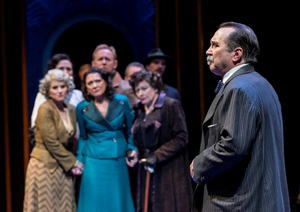Review: MURDER ON THE ORIENT EXPRESS Blends Comedy and Crime at Pittsburgh Public Theater
Ken Ludwig's mystery farce works better than you'd imagine
 I'll admit, when I heard Ken Ludwig had adapted Murder on the Orient Express I was dubious. Ludwig is a legendary mastery of the stage farce, whose work is produced so ubiquitously that nearly every every theatregoer can choose to attend a Ken Ludwig play near them at almost any time. But the Agatha Christie estate specifically requested Ludwig to adapt Christie's most famous mystery, so I kept an open mind. To my great surprise and utter delight, the proposition was a right one: it turns out that all Agatha Christie had ever been missing was laughs.
I'll admit, when I heard Ken Ludwig had adapted Murder on the Orient Express I was dubious. Ludwig is a legendary mastery of the stage farce, whose work is produced so ubiquitously that nearly every every theatregoer can choose to attend a Ken Ludwig play near them at almost any time. But the Agatha Christie estate specifically requested Ludwig to adapt Christie's most famous mystery, so I kept an open mind. To my great surprise and utter delight, the proposition was a right one: it turns out that all Agatha Christie had ever been missing was laughs.
Murder on the Orient Express, as any fan of mystery novels OR all-star movies can tell you, is an ensemble drama with an irresistible hook: when world's greatest detective Hercule Poirot (Martin Giles, perfectly cast) is snowed in on a transcontinental train, he happens to be in the right place at the right time to solve a truly improbable murder. Almost everyone is a suspect, but almost everyone has an alibi. Whodunit, indeed? As directed by Marya Sea Kaminski, the Ludwig adaptation streamlines the famously complicated novel and screen story: rather than upwards of twelve suspects and key players, we drop down to eight instead.
Kaminski's command of the tightly-wound ensemble cast is deft and masterful; with nothing but two divans and a turntable, she conjures an entire hotel and railway train out of light, sound and character. Naturally, this is Poirot's show, and Pittsburgh legend Martin Giles is clearly having the time of his life. Poirots come in two categories, the somber and regretful, and the rascally and charming. Giles is most assuredly (and most blessedly) in the second category; the running gag in which he repeatedly contemplates having an affair had the audience in stitches, as Giles gave Poirot enough charm to never once register as a dirty old man. His frequent compatriot James FitzGerald makes a great recurring double act with Giles, most notably as a cocksure table waiter. Ricardo Vila-Roger, as Poirot's friend and companion Monsieur Bouc, is completely charming and natural as the "Watson" to whom Poirot must often explain clues or bounce theories; he never allows the character, and thus the audience by proxy, to come across as slow, clueless or hopelessly lost.
The cast of suspects are just as colorful, and full of beloved Pittsburgh regulars. Caroline Nicolian, a regular at CLO, deftly navigates a Balkan accent as doctor-turned-noblewoman Countess Andrenyi. Radiating brains and drive while affecting an aristocrat's glamour, it's no wonder Poirot would be instantly charmed by such a person. David Whalen's dual role as the dour Colonel Arbuthnott and the swaggering American gangster Ratchet was so convincing that I did not realize they were the same actor until I consulted my program. And, of course, there is Lenora. No parade of Pittsburgh all-stars would be complete without Broadway legend Lenora Nemetz in a featured role. Nemetz chews the scenery divinely as a meddling, obnoxious, snoopy American tourist... oh, hell, let's just say it, she's playing a Karen. And nobody does it better than Nemetz, because no matter how annoying she makes the character of Helen Hubbard, the audience just loves her more and more.
I'll admit, there are moments where the farce and the very dark mystery plot butt heads a little; I had a similar problem when my noir/farce adaptation of The Cabinet of Doctor Caligari had its workshop premiere. Thankfully, playwright Ludwig and director Kaminski strike an ideal balance of the silly and the serious, allowing the characters to simply be funny people in an unfunny situation. It works- this may be the first time audiences leave an Agatha Christie production with a big smile on their faces. Kenneth Branagh, eat your heart out.
Reader Reviews
Videos

